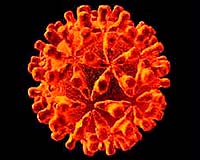| . |  |
. |
Washington (AFP) Oct 12, 2009 Adolescents and relatively healthy adults are especially at risk from the swine flu, which is associated with respiratory failure and a high mortality rate in serious cases, studies said Monday. The studies, conducted during the first phase of infection between March 18 and June 1 in Mexico and April 16 through August 12 in Canada, also show how emergency services were sometimes submerged by the number of serious cases that needed to be treated simultaneously. Serious cases of infection from the influenza A(H1N1) virus in patients in Mexico were all linked to severe acute respiratory distress syndrome, followed by a state of shock with a high incidence of death. At least 4,525 people have died from swine flu infections since April and there have been over 378,223 laboratory-confirmed cases, the World Health Organization said Friday, with most deaths occurring in the Americas. Of the 899 patients admitted to six Mexican hospitals with confirmed or probable A(H1N1) infections during the period studied, 58 were in serious condition, the study's authors said. The median age of critically ill patients was 44. Most were treated with antibiotics and 45 of them with the antivirals Tamiflu or Relenza, while 54 required an artificial respirator. Among the 58 serious cases, 24 (41.4 percent) died within 60 days of hospitalization, including 19 during the first two weeks. "Our analysis of critically ill patients with 2009 influenza A(H1N1) reveals that this disease affected a young patient group," wrote the authors of the study led by Guillermo Dom�nguez-Cherit of the Instituto Nacional de Ciencias M�dicas y Nutrici�n in Mexico City. "Early recognition of disease by the consistent symptoms of fever and a respiratory illness during times of outbreak" accompanied by "prompt medical attention," the authors said, "may provide opportunities to mitigate the progression of illness and mortality observed in Mexico." In "almost all cases," fever and respiratory symptoms were harbingers of disease, they added. "There was a relatively long period of illness prior to presentation to the hospital, followed by a short period of acute and severe respiratory deterioration." Of the 168 patients infected with the virus who became critically ill and were treated at 38 Canadian hospitals during the period studied, 24 (14.3 percent) died within the first 28 days and five within the first 90 days, for a 17 percent mortality rate, according to that study's authors. The Canadian patients' average age was 32.3 years old, including 113 women (67.3 percent) and 50 people under the age of 18 (29.8 percent). The study team led by Anand Kumar of St. Boniface Hospital in Winnipeg, Canada, concluded that A (H1N1) caused serious illness predominantly in young patients with few major underlying diseases. "Our data suggest that severe disease and mortality in the current outbreak is concentrated in relatively healthy adolescents and adults between the ages of 10 and 60 years, a pattern reminiscent of the W-shaped curve [rise and fall in the population mortality rate for the disease, corresponding to age at death] previously seen only during the 1918 H1N1 Spanish pandemic," the authors write. Published in the November 4 edition of the Journal of the American Medical Association (JAMA), the studies were posted online on Monday to coincide with their presentation at a meeting of the European Society of Intensive Care Medicine in Vienna this week. In a JAMA editorial accompanying the studies, two doctors warned that many US hospitals could face a shortage of doctors and nurses to treat serious cases if the pandemic intensifies. "Hospitals must develop explicit policies to equitably determine who will and will not receive life support should absolute scarcity occur," wrote Douglas White and Derek Angus of the University of Pittsburgh School of Medicine. "Any deaths from 2009 influenza A(H1N1) will be regrettable, but those that result from insufficient planning and inadequate preparation will be especially tragic." The number of pediatric deaths linked to the A(H1N1) virus has risen sharply in the past month in the United States, with 19 dead between September 27 and October 3, according to the Centers for Disease Control and Prevention (CDC). A total of 76 children have died after being infected by the virus since April, the CDC said. Share This Article With Planet Earth
Related Links Epidemics on Earth - Bird Flu, HIV/AIDS, Ebola
 China to stop mandatory hepatitis B tests: state media
China to stop mandatory hepatitis B tests: state mediaBeijing (AFP) Oct 11, 2009 China will stop mandatory hepatitis B tests for employees joining new companies and students enrolling in schools, state media said Sunday, after a court ruled the tests were illegal discrimination. Deng Haihua, deputy director of the health ministry's general office, said the government would soon issue instructions to stop the practice, which is currently a requirement, the official ... read more |
|
| The content herein, unless otherwise known to be public domain, are Copyright 1995-2009 - SpaceDaily. AFP and UPI Wire Stories are copyright Agence France-Presse and United Press International. ESA Portal Reports are copyright European Space Agency. All NASA sourced material is public domain. Additional copyrights may apply in whole or part to other bona fide parties. Advertising does not imply endorsement,agreement or approval of any opinions, statements or information provided by SpaceDaily on any Web page published or hosted by SpaceDaily. Privacy Statement |